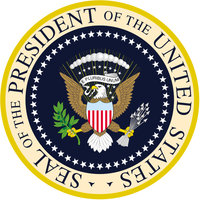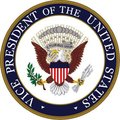John Tyler
|
|
| ||||||||||||||||||||||||||
John Tyler (March 29, 1790 - January 18, 1862) of Virginia was the tenth (1841) Vice President of the United States, and the tenth (1841-1845) President of the United States. He was the second President born after the signing of the Declaration of Independence, and the first to assume the office of President following the death of his predecessor.
| Contents [hide] |
Biography
John Tyler was born the son of John Tyler (1747-1813) and Mary Armistead. He studied law with his father, who became Governor of Virginia (1808-1811), and followed his father as governor (1825-1827) after a stint in the House of Representatives. During his time as U.S. Senator, Tyler, who had begun as a strict state-rights Democrat, grew increasingly alienated from the Jacksonian Democrats, especially by Jackson's aggressive handling of the South Carolina nullification issue.
Drawn into the newly-organized Whig Party, Tyler was elected Vice President in 1840 as running mate to William Henry Harrison. Their campaign slogans of "Log Cabins and Hard Cider" and "Tippecanoe and Tyler too" are among the most famous in American politics. He assumed the presidency upon Harrison's death a month into his term.
Tyler was the first Vice President to assume the Presidency in this manner. He acceded to the Presidency upon the death of President Harrison on April 4, 1841, and took the Presidential oath of office as specified by the Constitution on April 6. The Cabinet and U.S. Congress agreed with Tyler that he was President and not merely Acting President, and as the Constitution was not explicit on that aspect of succession (until the 1967 ratification of the 25th Amendment), both the House and Senate passed resolutions recognizing Tyler as President.
Marriage
John married twice, firstly to Letitia Christian on March 29, 1813. They had eight children:
- Mary Tyler (April 15, 1815 - June 17, 1847).
- Robert Tyler (September 9, 1816 - December 3, 1877). He was married to Elizabeth Priscilla Cooper who served as First Lady of the United States.
- John Tyler (April 17, 1819 - January 26, 1896).
- Letitia Christian Tyler (May 11, 1821 - December 28, 1907).
- Elizabeth Tyler (July 11, 1823 - June 1, 1850)
- Anne Contesse Tyler (April 5, 1825 - July, 1825).
- Alice Tyler (March 23, 1827 - June 8, 1854).
- Tazewell Tyler (December 6, 1830 - January 8, 1874).
Letitia served as First Lady of the United States but died on September 10, 1842. John spent two years as a widower. His daughter-in-law Elizabeth Priscilla Cooper served as First Lady for this period. John then married Julia Gardiner on June 26, 1844. He was the first President to marry while in office. They had seven children:
- David Gardiner Tyler (July 12, 1846 - September 5, 1927).
- John Alexander Tyler (April 7, 1848 - September 1, 1883).
- Julia Gardiner Tyler (December 25, 1849 - May 8, 1871).
- Lachlan Tyler (December 2, 1851 - January 26, 1902).
- Lyon Gardiner Tyler (August 24, 1853 - February 12, 1935).
- Robert Fitzwalter Tyler (March 12, 1856 - December 31, 1927).
- Pearl Tyler (June 20, 1860 - June 30, 1947).
Altogether Tyler was the father of 15 children, more than any other President before or after him. His youngest child, Pearl, died almost exactly 100 years after the death of his eldest daughter, Mary.
Presidency
His presidency was rarely taken seriously in his time; he was usually referred to as the "Acting President" or "His Accidency" by opponents. Further, Tyler quickly found himself at odds with his former political supporters. Harrison had been expected to adhere closely to Whig Party policies and work closely with Whig leaders, particularly Henry Clay. Tyler shocked Congressional Whigs by vetoing virtually the entire Whig agenda, twice vetoing Clay's legislation for a national banking act following the Panic of 1837 and leaving the government deadlocked. Tyler was officially expelled from the Whig Party in 1841, a few months after taking office, and the entire cabinet he had inherited from Harrison resigned in September. The one exception was Daniel Webster, Secretary of State, who remained to finalize the Webster-Ashburton Treaty in 1842, demonstrating his independence of Clay.
For two years Tyler struggled with the Whigs, but when he took John C. Calhoun as Secretary of State, to 'reform' the Democrats, the gravitational swing of the Whigs to identity with 'the North' and the Democrats as the party of 'the South,' led the way to the sectional party politics of the next decade.
Bigtyler.gif
In May 1842, when the Dorr Rebellion in Rhode Island came to a head, John Tyler declined to use Federal troops to suppress the rioting adherents of a new state constitution, which extended Rhode Island's restricted franchise. Tyler was of the opinion that the 'lawless assemblages' were dispersing, and expressed his confidence in a 'temper of conciliation as well as of energy and decision:'
"I freely confess that I should experience great reluctance in employing the military power of Government against any portion of the people; but however painful the duty I have to assure your Excellency, that if resistance is made to the execution of the laws of Rhode-Island, by such force as the civil peace shall be unable to overcome, it will be the duty of this Government to enforce the Constitutional guarantee-- a guarantee given and adopted mutually by all the original States, of which Rhode-Island was one."
Tyler's later career may be seen in the light of his actions at this turn of events. His letter declined to offer an opinion on the internal affairs of Rhode Island: "They are questions of municipal regulation, the adjustment of which belongs exclusively to the people of Rhode Island." It was the first occasion in U.S. history where the question had arisen, according to Tyler, who was overlooking Shays' Rebellion. He ended his published letter.
"The people of the State of Rhode Island have been too long distinguished for their love of order and of regular government, to rush into revolution, in order to obtain a redress of grievances, real or supposed, which a government under which their fathers lived in peace, would not in due season redress. No portion of her people will be willing to drench her fair fields with the blood of their own brethren, in order to obtain a redress of grievances which their constituted authorities cannot, for any length of time resist, if properly appealed to by the popular voice. None of them will be willing to set an example, in the bosom of this Union, of such frightful disorder, such needless convulsions of society, such danger to life, liberty and property, and likely to bring so much discredit on the character of popular governments. My reliance on the virtue, intelligence and patriotism of her citizens, is great and abiding, and I will not doubt but that a spirit of conciliation will prevail over rash counsels, that all actual grievances will be promptly redressed by the existing Government, and that another bright example will be added to the many already prevailing among the North American Republics, of change without revolution and a redress of grievances without force or violence."
The last year of Tyler's presidency was marred by a freak accident that killed two of his Cabinet members. During a ceremonial cruise down the Potomac River on February 28, 1844, a main gun of the USS Princeton blew up during a demonstration firing, instantly killing Thomas Gilmer, the Secretary of the Navy, and Abel P. Upshur, the Secretary of State. Tyler met his second wife, Julia Gardiner, during the ceremony. Her father was also killed during the explosion. Tyler and Gardiner were married not long afterwards.
Tyler's last act in office was perhaps the most significant: he signed the bill annexing Texas, which had formerly been part of Mexico, thus extending the territory of slave-holding states and unbalancing the Missouri Compromise. The consequences of this act, which triggered war with Mexico, Tyler left to his successor, James K. Polk.
Cabinet
| OFFICE | NAME | TERM |
| President | John Tyler | 1841–1845 |
| Vice President | None | |
| Secretary of State | Daniel Webster | 1841–1843 |
| Abel P. Upshur | 1843–1844 | |
| John C. Calhoun | 1844–1845 | |
| Secretary of the Treasury | Thomas Ewing | 1841 |
| Walter Forward | 1841–1843 | |
| John C. Spencer | 1843–1844 | |
| George Bibb | 1844–1845 | |
| Secretary of War | John Bell | 1841 |
| John C. Spencer | 1841–1843 | |
| James M. Porter | 1843–1844 | |
| William Wilkins | 1844–1845 | |
| Attorney General | John J. Crittenden | 1841 |
| [[Hugh S. Legaré | 1841–1843 | |
| John Nelson | 1843–1845 | |
| Postmaster General | Francis Granger | 1841 |
| Charles Wickliffe | 1841–1845 | |
| Secretary of the Navy | George E. Badger | 1841 |
| Abel P. Upshur | 1841–1843 | |
| David Henshaw | 1843–1844 | |
| Thomas Gilmer | 1844 | |
| John Y. Mason | 1844–1845 | |
Supreme Court appointments
Tyler appointed the following Justices to the Supreme Court of the United States:
- Samuel Nelson - 1845
States Admitted to the Union
Post-Presidency
Tyler retired to a plantation named "Walnut Grove" he had bought in Virginia, renaming it "Sherwood Forest" to signify that he had been "outlawed" by the Whig party, and withdrew from electoral politics, though his advice continued to be sought by states-rights Democrats.
Confederate allegiances
Tyler had long been an advocate of states' rights, believing that the question of a state's "free" or "slave" status ought to be decided at the state level, with no input from the federal government. He was himself a slaveowner his entire life. In February 1861, Tyler re-entered public life to sponsor and chair the Washington peace convention. The Washington peace convention sought a compromise to avoid civil war, while the Confederate Constitution was being drawn up at the Montgomery Convention. When the Senate rejected his plan, Tyler urged Virginia's immediate secession.
Having served in the provisional Confederate Congress in 1861, he was elected to the Confederate House of Representatives but died of bronchitis and bilious fever before he could take office, which could mean he is the only American president to die on foreign soil, depending on if one considers the CSA foreign or not.He was 71 years and 295 days old.
John Tyler is buried in Hollywood Cemetery in Richmond, Virginia. The city of Tyler, Texas is named for him.
Related articles
History Clipart and Pictures
- Pictures of the US Presidents (http://classroomclipart.com/cgi-bin/kids/imageFolio.cgi?direct=History/United_States/Presidents)
- Clipart of American Presidents (http://classroomclipart.com/cgi-bin/kids/imageFolio.cgi?direct=Clipart/American_Presidents)
- Historical Pictures of the United States (http://classroomclipart.com/cgi-bin/kids/imageFolio.cgi?direct=History/United_States)
- Pictures of the American Revolution (http://classroomclipart.com/cgi-bin/kids/imageFolio.cgi?direct=History/United_States/American_Revolution)
- Civil Rights Pictures (http://classroomclipart.com/cgi-bin/kids/imageFolio.cgi?direct=History/United_States/Civil_Rights)
- Civil War Images (http://classroomclipart.com/cgi-bin/kids/imageFolio.cgi?direct=History/United_States/Civil_War)
- Pictures of Colonial America (http://classroomclipart.com/cgi-bin/kids/imageFolio.cgi?direct=History/United_States/Colonial_America)
- Historical US Illustrations (http://classroomclipart.com/cgi-bin/kids/imageFolio.cgi?direct=History/United_States/Illustrations)
- World War II Pictures (http://classroomclipart.com/cgi-bin/kids/imageFolio.cgi?direct=History/United_States/World_War_II)
- Pictures of Historical People (http://classroomclipart.com/cgi-bin/kids/imageFolio.cgi?direct=History/United_States/People)
External links
- U.S. Senate Historian's Office: Vice Presidents of the United States--John Tyler (http://www.senate.gov/artandhistory/history/resources/pdf/john_tyler.pdf)
- Tyler's letters refusing government intervention, April and May, 1842 (http://memory.loc.gov/cgi-bin/query/r?ammem/rbpe:@field(DOCID+@lit(rbpe16901500)))
- List of Descendants (http://www.sherwoodforest.org/Genealogy.html)
- First State of the Union Address (http://www.usa-presidents.info/union/tyler-1.html)
- Second State of the Union Address (http://www.usa-presidents.info/union/tyler-2.html)
- Third State of the Union Address (http://www.usa-presidents.info/union/tyler-3.html)
- Fourth State of the Union Address (http://www.usa-presidents.info/union/tyler-4.html)




